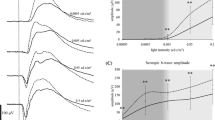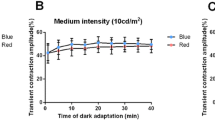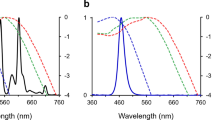Abstract
Purpose: Previous reports have raised the possibility that, compared to pigmented rats, albino rats might be night blind. The purpose of this study was to reinvestigate this issue by comparing the dark-adaptation process of the pigmented Long-Evans (LE) and albino Sprague Dawley (SD) rats. Methods: Scotopic ERGs obtained from LE and SD rats were recorded following periods of dark adaptation 0.5, 3 and 12 h. Intensity response functions were generated with flashes of white light spanning over a 7 log-unit range with a maximal intensity of 8 cd.s.m−2 in energy. Results: SD rats showed a gradual increase in the amplitude of the scotopic b-wave Vmax (maximal `saturated' rod b-wave amplitude) and retinal sensitivity (k) as the duration of the dark-adaptation period increased. In contrast, LE rats did not demonstrate any further significant gain in retinal function (Vmax or k) beyond 30 min of dark-adaptation. Thus for periods of dark-adaptation of 30 min or less, the rod function of the LE rats is superior to that of the SD rats while both strains have comparable retinal functions following 3 h or more of dark-adaptation. Conclusions: Our results indicate that LE and SD rats differ in their rapidity to dark-adapt, a finding that could explain the previous claim that SD rats were night blind. The reduced bio-availability of calcium ions in eyes lacking melanin could explain this difference. Calcium was previously shown to play a key role in retinal adaptation processes.
Similar content being viewed by others
References
Balkema GW. Elevated dark-adapted thresholds in albino rodents. Invest Ophthalmol Vis Sci 1988; 29: 544–549.
Green DG, De Tajada PH, Glover MJ. Are albino rats night blind? Invest Ophthalmol Vis Sci 1991; 32: 2366–2371.
Dodt E, Echte K. Dark and light adaptation in pigmented and white rat as measured by electroretinogram threshold. J Neurophysiol 1961; 24: 427–445.
Cayouette M, Behn D, Sendtner M, Lachapelle P, Gravel C. Intraocular gene transfer of ciliary neurotrophic factor prevents death and increases responsiveness of rod photoreceptors in the retinal degeneration slow (rds) mouse. J Neurosci 1998; 18: 9282–9293.
Dembinska O, Rojas LM, Varma DR, Chemtob S, Lachapelle P. Graded contribution of retinal maturation to the development of oxygen-induced retinopathy in rats. Invest Ophthalmol Vis Sci 2001; 42: 1111–1118.
Hayes JM, Balkema GW. Elevated dark-adapted thresholds in hypopigmented mice measured with a water maze screening apparatus. Behav Genet 1993; 23: 395–403.
Balkema GW, Drager UC. Impaired visual thresholds in hypopigmented animals. Vis Neurosci 1991; 6: 577–585.
Nakatani K, Yau KW. Calcium and light adaptation in retinal rods and cones. Nature 1988; 334: 69–71.
Torre V, Mathews HR, Lamb TD. Role of calcium in regulating the cyclic GMP cascade of phototransduction in retinal rods. Proc Natl Acad Sci (USA) 1986; 83: 7109–7113.
Koutalos Y, Yau KW. Regulation of sensitivity in vertebrate rod photoreceptors by calcium. Trends Neurosci 1996; 19: 73–81.
Drager UC. Calcium binding in pigmented and albino eyes. Proc Natl Acad Sci (USA) 1985; 82: 6716–6720.
Author information
Authors and Affiliations
Rights and permissions
About this article
Cite this article
Behn, D., Doke, A., Racine, J. et al. Dark adaptation is faster in pigmented than albino rats. Doc Ophthalmol 106, 153–159 (2003). https://doi.org/10.1023/A:1022511918823
Issue Date:
DOI: https://doi.org/10.1023/A:1022511918823




